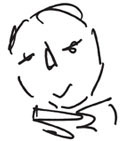Anthony Haden-Guest on Meditation | Mediation

Some words frighten the American art world. One such word is humor. Europeans tend to be comfortable with the notion that art can be witty, even funny. Francesco Vezzoli says that when his Caligula remake was premiered at the Venice Biennale, the audience roared with laughter. When it was screened at the Whitney Biennial the crowd were as solemn as if they were in church. Claes Oldenberg was insistent that there was no element of humor in his work. Even Dennis Oppenheim said it was something he approached in a gingerly fashion. The reason, I think, is that we have been conditioned to treat art objects, even art performances, as discrete, as totalities, not as channeling something large, different, and not necessarily manageable.
This is a roundabout way of approaching another complex of words and associations with which the art world is even less comfortable than with something as human as humor. I refer to the spiritual, the sublime, the mystical, and the very words can trigger an involuntary recoil, as from New Age music or Druid ceremonies at Stonehenge, even when the art operates at the very highest level. Most, for instance, will be somewhat aware that Malevich, Mondrian and Kandinsky had profound belief systems and that what Rothko and Barnett Newman intended was at some level a religious experience but I wonder how many prepare themselves for the transmission? Or, if prepared, receive it? Anyway, there’s something about the sleek bazaar hum of the art world – the white box gallery, the auctioneer at his podium – which effects the meditative process rather as strip-mining does agriculture.
This is territory that Daniel Rothbart enters fearlessly, indeed with a sort of Petit Prince innocence, except that his means are clean, economical and indeed sophisticated. The timeline that he furnishes begins with his first experience of the Japanese tea ceremony in Portland, Oregon. He notes that as a Fulbright Scholar in Italy at the beginning of the 90s he made eighteen bronze vessels. In 1994 he published an essay, Jewish Metaphysics as Generative Principle in American Art, a book that the late Jonathan Napack described in the New York Observer as “The Most Obscure Yet Weirdly Fascinating Art Book” of that year. The following year he cast twelve portable aluminum vessels and three larger ones in New York. And he was ready to set off on what it would seem appropriate to call his journey.
Rothbart’s aluminum sculptures include biomorphic forms that can resemble actual branches or branch coral and, even had I not been aware of the properties of aluminum, I believe I would have sensed a curious combination of earthiness to the shapes with a giddy feeling of weightlessness. But the principal sculptures are the bowls. And with the bowls that sense of near weightlessness is strengthened – or is it complicated? – by the fact that they are also ritual objects. They are the central element in Rothbart’s series of Meditation/Mediations.
It was in New York that I participated in a Meditation/Mediation, one of a series that he had initiated in the Baruchello Foundation in Rome and which have since been performed in Mexico, Israel, Serbia, France and elsewhere in the US. Rothbart is a Buddhist and the vessels, which do not have the functional form of conventional cooking vessels but the bud-like shape of a young woman’s breast, are of course, as an element, drenched in history, myth and ritual but there is no obvious religiosity to the ceremony (of the sort that, for instance, I find so hokey and annoying about Herman Nitsch’s performances). Rothbart simply calls them “Begging Bowls.”
Participants, who have included Yoko Ono, Max Blagg, Adrian Dannatt and what Walter Robinson of ArtNet describes as “a naked odalisque”, simply do with the vessels and a long rod, also in aluminum, and tipped with what appears to be a pear evolving into triplets, whatever comes to mind, whether making music from them, wearing one as a fancy hat, or, in the case of the naked odalisque stretching out alongside, and cradling an opium pipe, having placed a Magrittean green apple in each and every bowl.
New York, September 9, 2011